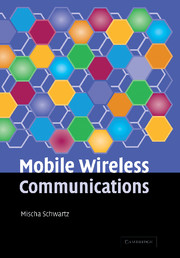Book contents
- Frontmatter
- Contents
- Preface
- 1 Introduction and overview
- 2 Characteristics of the mobile radio environment–propagation phenomena
- 3 Cellular concept and channel allocation
- 4 Dynamic channel allocation and power control
- 5 Modulation techniques
- 6 Multiple access techniques: FDMA, TDMA, CDMA; system capacity comparisons
- 7 Coding for error detection and correction
- 8 Second-generation, digital, wireless systems
- 9 Performance analysis: admission control and handoffs
- 10 2.5G/3G Mobile wireless systems: packet-switched data
- 11 Access and scheduling techniques in cellular systems
- 12 Wireless LANs and personal-area networks
- References
- Index
3 - Cellular concept and channel allocation
Published online by Cambridge University Press: 05 June 2012
- Frontmatter
- Contents
- Preface
- 1 Introduction and overview
- 2 Characteristics of the mobile radio environment–propagation phenomena
- 3 Cellular concept and channel allocation
- 4 Dynamic channel allocation and power control
- 5 Modulation techniques
- 6 Multiple access techniques: FDMA, TDMA, CDMA; system capacity comparisons
- 7 Coding for error detection and correction
- 8 Second-generation, digital, wireless systems
- 9 Performance analysis: admission control and handoffs
- 10 2.5G/3G Mobile wireless systems: packet-switched data
- 11 Access and scheduling techniques in cellular systems
- 12 Wireless LANs and personal-area networks
- References
- Index
Summary
Channel reuse: introduction of cells
In the previous chapter we focused on propagation effects over the radio link between a base station and a mobile terminal. We noted there that most modern wireless systems are organized into geographic cells, each controlled by a base station. (Among the exceptions, as noted there, are small-area systems such as local-area wireless networks and personal-area networks, to be discussed in Chapter 12. Ad hoc and wireless sensor networks, not discussed in this book, are other examples of networks not necessarily involving the cellular concept.) We were thus implicitly discussing the propagation effects encountered in a single cell. In this chapter we introduce the cellular concept, showing how the use of cells can increase the capacity of a wireless system, allowing more users to communicate simultaneously.
The number of simultaneous calls a mobile wireless system can accommodate is essentially determined by the total spectral allocation for that system and the bandwidth required for transmitting signals used in handling a call. This is no different than the case for other radio applications such as broadcast radio, AM or FM, or broadcast TV. As an example, consider the first-generation analog mobile system in the US, the AMPS system. Here 25 MHz of spectrum is made available for each direction of transmission in the 800–900 MHz radio band.
- Type
- Chapter
- Information
- Mobile Wireless Communications , pp. 62 - 80Publisher: Cambridge University PressPrint publication year: 2004



